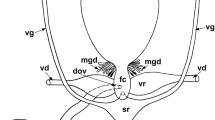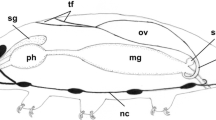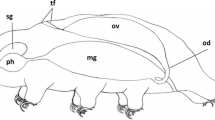Summary
This paper deals with the ultrastructure of the glands that secrete the ootheca in the female of three groups of the super order Orthopteroidea: Acridoidea, Blattoidea and Mantoidea. Among the Orthopteroidea these three are the only groups that secrete hardened and complex oothecae. Whereas in the Blattoidea and Mantoidea they are secreted by the primitive colleterial glands that open into the unpaired oviduct, in the more recently evolved Acridoidea the secretion is the product of two loops of the paired oviducts (pseudocolleterial glands). These take the place of the colleterial glands lost in the phylogeny of the order. In fact, the ultrastructure of pseudocolleterial glands is typical of recently acquired organs. The two glands are alike and are composed of the same type of cells throughout. These cells secrete all the products that make up the ootheca: enzymes, structural proteins, and polysaccharides.
The two colleterial glands of the most ancient of these three groups of Orthopteroidea, the Blattoidea, are diverse. In the left-hand one, zones can be differentiated. One, rich in ergastoplasm, produces structural proteins and the other, rich in mitochondria, produces a phenoloxidase. The gland on the right also consists of zones: one, rich in ergastoplasm, that secretes β-glucoxidase, and the other, with abundant Golgi elements and glucidic granules, that elaborates a polysaccharide.
In the Mantoidea there are five glands. One pair is made up of numerous tubules that produce a glucidic and proteinaceous secretion from copious ergastoplasm. In a second pair each gland is branched and subdivided into two diverse parts. The zone at the origin of the gland (like the left-hand zone of Periplaneta rich in mitochondria) secretes an oxidase, whereas the distal portion (like the right-hand zone of Periplaneta, rich in ergastoplasm) secretes a glucoxidase. The fifth gland, unpaired, has the characteristics of an organ that elaborates carbohydrates and proteins and releases calcium, which is added to the secretion.
Riassunto
La presente ricerca ultrastrutturistica è stata condotta sulle ghiandole che secernono l'ooteca nella femmina degli Ortotteri Acridoidei, dei Blattoidei e dei Mantoidei. Questi tre gruppi sono i soli, fra gli Ortotteroidei, che secernono ooteche indurite e complesse, ma mentre nei Blattoidei e Mantoidei alla secrezione presiedono le primitive ghiandole colleteriche, che sboccano nell'ovidutto impari, negli Acridoidei, che sono di più recente comparsa e (fra gli Ortotteri) i più recentemente evoluti, la secrezione è opera di due diverticoli degli ovidutti pari (ghiandole pseudocolleteriche) che sostituiscono le vere colleteriche perdute lungo la filogenesi dell'ordine Orthoptera. La ultrastruttura delle ghiandole pseudocolleteriche è infatti quella di un tipico organo di recente acquisizione: le due ghiandole sono uguali fra loro, e composte di cellule simili per la intera lunghezza, che secernono tutti i prodotti costituenti l'ooteca: enzimi, proteine strutturali, polisaccaridi.
Le due ghiandole colleteriche degli Ortotteroidei più antichi, i Blattoidei, sono invece diverse fra di loro: la sinistra differenzia due tratti secretori: uno ricco di ergastoplasma (che elabora proteine strutturali) ed uno di mitocondri (che elabora una fenolossidasi); la destra pure due tratti, uno con prevalente ergastoplasma (secretore di β-glucosidasi) ed uno con abbondanti Golgi e granuli glucidici (elaboratore di un polisaccaride).
Nei Mantoidei vi sono 5 ghiandole: una coppia, costituite da numerosi tubuli, che elaborano, da un abbondante ergastoplasma, un secreto protidico e glucidico; una seconda coppia (ramificate e suddivise ciascuna in due diversi tratti) che secernono a monte una ossidasi (sono simili al tratto ricco di mitocondri della sinistra di Periplaneta) e a valle una glucosidasi (sono simili al tratto ricco di ergastoplasma della destra di Periplaneta). La quinta ghiandola, impari, ha i caratteri degli organi secretori di glucidi e protidi e secerne Calcio che viene aggiunto al secreto.
Similar content being viewed by others
Bibliografia
Baccetti, B.: Reperti sull'accrescimento nucleare nelle ghiandole colleteriche degli Acridoidei (Osservazioni citologiche ed istofotometriche). Boll. Zool. U.Z.I. 26, 137–142 (1959).
—: Il problema della secrezione della ooteca negli Ortotteroidei alla luce delle più recenti acquisizioni. Atti Accad. Naz. ital. Ent., Rendiconti 8, 112–136 (1961).
—: Sulla presenza di fibrille collagene in alcune membrane basali e nella tunica dei corpi grassi di un Ortottero. Monit. zool. ital. 70–71, 361–367 (1963).
Brunet, P.C.J.: The formation of the ootheca by Periplaneta americana. I. The microanatomy and histology of the posterior part of the abdomen. Quart. J. micr. Sci. 92, 113–127 (1951).
Brunet, P. C. J.: The formation of the ootheca by Periplaneta americana. II. The structure and function of the left colleterial gland. Quart. J. micr. Sci. 93, 47–70 (1952).
—, and P. W. Kent: Observations on the mechanism of a tanning reaction in Periplaneta and Blatta. Proc. roy Soc. B 144, 259–274 (1955).
Eisner, Th., J. Shepherd, and G. M. Happ: Tanning of grasshopper eggs by an exocrine secretion. Science 152, 95–97 (1966).
Guardabassi, A.: Le caratteristiche citologiche, ultrastrutturali, istochimiche e biochimiche di alcuni tessuti e organi che partecipano alla elaborazione di strutture calcificate. Monit. zool. ital. 70, 1–55 (1962).
Kato, K., and K. Kubomura: Composition of the Packet of the Praying Mantis. Sci. Rep. Saitama Univ. B2, 165–182 (1956).
Kugler, O., P. Frankenstein, and K. Rafferty: Histochemical localization of alkaline phosphatase, glycogen and nucleic acids in the female reproductive organs of the cockroach, Periplaneta americana. J. Morph. 98, 235–250 (1956).
Lauverjat, S.: Données histologiques et histochimiques sur les voies génitales femelles et sur la sécrétion de l'oothèque chez quelques Acridiens. Ann. Soc. ent. France 1, 879–935 (1965).
Mercer, E. H., and P.C.J. Brunet: The electron microscopy of the left colleterial gland of the cockroach. J. biophys. biochem. Cytol. 5, 257–261 (1959).
Parker, K. D., and K. M. Rudall: Calcium citrate in an insect. Biochim. biophys. Acta (Amst.) 17, 287 (1955).
Phillips, D. M., and H. Swift: Cytoplasmic fine structure of Sciara salivary glands. I. Secretion. J. Cell Biol. 27, 395–409 (1965).
Pryor, M.G.M.: On the hardening of the ootheca of Blatta orientalis. Proc. roy. Soc. B. 128, 378–393 (1940).
Rudall, K. M.: Protein ribbons and sheets. Lect. sci. Basis Med. 5, 217–230 (1956).
—: Skeletal structure in insects. In: Aspect of insect biochemistry (edit. T.W. Goodwin), p. 83–92. London and New York: Academic Press 1965.
Author information
Authors and Affiliations
Additional information
Research performed under C.N.R. contract.
Rights and permissions
About this article
Cite this article
Baccetti, B. L'ultrastruttura delle ghiandole della ooteca in Ortotteri Acridoidei, Blattoidei e Mantoidei. Zeitschrift für Zellforschung 77, 64–79 (1967). https://doi.org/10.1007/BF00336699
Received:
Issue Date:
DOI: https://doi.org/10.1007/BF00336699




